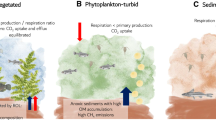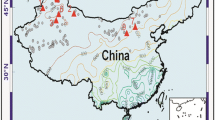Abstract
To study the role of large and shallow hemiboreal lakes in carbon processing, we calculated a 3-year carbon mass balance for Lake Võrtsjärv (Estonia) based on in situ measurements. This balance took into account hydrological and biogeochemical processes affecting dissolved inorganic (DIC), dissolved organic (DOC) and particulate organic (POC) carbon species. Accumulation varied greatly on a seasonal and yearly basis. The lake exported carbon during most of the year except during spring floods and in late autumn. In-lake processes were responsible for exporting POC and storing DOC while DIC switched between storage and export. The carbon cycle was alternatively dominated in 2009 by biogeochemical processes and in 2011 by riverine fluxes, whereas in 2010 the two process types were of the same magnitude. These results suggest that the role of large shallow lakes like Võrtsjärv in the global C cycle is equally driven by hydrological factors, in particular seasonal water level changes, and by biogeochemical in-lake reactions.







Similar content being viewed by others
References
Andersson, E. & S. Sobek, 2006. Comparison of a mass balance and an ecosystem model approach when evaluating the carbon cycling in a lake ecosystem. Ambio 35: 476–483.
Cole, J. J., N. F. Caraco, G. W. Kling & T. K. Kratz, 1994. Carbon dioxide supersaturation in the surface waters of lakes. Science 265: 1568–1570.
Cole, J. J., Y. T. Prairie, N. F. Caraco, W. H. McDowell, L. J. Tranvik, R. G. Striegl, C. M. Duarte, P. Kortelainen, J. A. Downing, J. J. Middelburg & J. Melack, 2007. Plumbing the global carbon cycle: integrating inland waters into the terrestrial carbon budget. Ecosystems 10: 171–184.
del Giorgio, P. A. & P. B. Williams, 2005. The global significance of respiration in aquatic ecosystems: from single cells to the biosphere. In del Giorgio, P. A. & P. J. Williams (eds), Respiration in Aquatic Ecosystems. Oxford University Press, New York: 266–303.
Demarty, M. & Y. Prairie, 2009. In situ dissolved organic carbon (DOC) release by submerged macrophyte–epiphyte communities in southern Quebec lakes. Canadian Journal of Fisheries and Aquatic Sciences 66: 1522–1531.
Dillon, P. J. & W. A. Molot, 1997. Dissolved organic and inorganic carbon mass balances in central Ontario lakes. Biogeochemistry 36: 29–42.
Downing, J. A., Y. T. Prairie, J. J. Cole, C. M. Duarte, L. J. Tranvik, R. G. Striegl, W. H. McDowell, P. Kortelainen, N. F. Caraco, J. M. Melack & J. J. Middelburg, 2006. The global abundance and size distribution of lakes, ponds, and impoundments. Limnology & Oceanography 51: 2388–2397.
EN 1484, 1992. Water Analysis Guidelines for the Determination of Total Organic Carbon (TOC) and Dissolved Organic Carbon (DOC). Eesti Standardikeskus, Tallinn.
Feldmann, T. & H. Mäemets, 2004. Macrophytes. In Haberman, J., E. Piku & A. Raukas (eds), Lake Võrtsjärv. Estonian Encyclopaedia Publishers, Tallinn: 185–205.
Feldmann, T. & P. Nõges, 2007. Factors controlling macrophyte distribution in large shallow Lake Võrtsjärv. Aquatic Botany 87: 15–21.
Finlay, K., P. R. Leavitt, A. Patoine & B. Wissel, 2010. Magnitudes and controls of organic and inorganic carbon flux through a chain of hardwater lakes on the northern Great Plains. Limnology & Oceanography 55: 1551–1564.
George, D. G., S. C. Maberly & D. P. Hewitt, 2004. The influence of the North Atlantic Oscillation on the physical, chemical and biological characteristics of four lakes in the English Lake District. Freshwater Biology 49: 760–774.
Heinsalu, A., H. Luup, T. Alliksaar, P. Nõges & T. Nõges, 2008. Water level changes in a large shallow lake as reflected by the plankton: periphyton-ratio of sedimentary diatoms. Hydrobiologia 599: 23–30.
ISO 8245, 1987. Water Quality Guidelines for the Determination of Total Organic Carbon (TOC). International Organization for Standardization, Switzerland.
Jaani, A., 1973. Hüdroloogia. In Timm, T. (ed.), Võrtsjärv. Valgus, Tallinn: 37–60.
Järvet, A., 2004a. Influence of hydrological factors and human impact on the ecological state of shallow Lake Võrtsjärv in Estonia. Dissertationes Geographicae Universitatis Tartuensis No 19, Tartu University Press. Tartu.
Järvet, A., R. Karukäpp & I. Arold, 2004. Location and physico-geographical conditions of the catchment area. In Haberman, J., E. Pihu & A. Raukas (eds), Lake Võrtsjärv. Estonian Encyclopedia Publishers, Tallinn: 11–28.
Kraatz, C. & P. Wochnik, 1998. Dr. Lange TOC Cuvette Test Conforms to European Standard. Application Report Ch. No. 60. Dr. Bruno Lange GmbH & Co, Düsseldorf.
Laas, A., P. Nõges, T. Kõiv & T. Nõges, 2012. High-frequency metabolism study in a large and shallow temperate lake reveals seasonal switching between net autotrophy and net heterotrophy. Hydrobiologia 694: 57–74.
McGarvey, H., D. Fountain & R. Turner, 2001. Pollen dispersal and nutrient input into aquatic ecosystems. In Rotorua Lakes 2001 Symposium, August 2001, Proceedings and Report. Lakes Water Quality Society.
Nielsen, G. Æ., & A. M. Bresta (eds), 1984. Guidelines for the measurement of phytoplankton primary production. Baltic Marine Biologists.
Nõges, P. & A. Järvet, 1995. Water level control over light conditions in shallow lakes. Report Series in Geophysics, University of Helsinki 32: 81–92.
Nõges, P., T. Nõges, 2013. Weak trends in ice phenology of Estonian large lakes despite significant warming trends. Hydrobiologia. doi:10.1007/s10750-013-1572-z.
Nõges, T. & P. Nõges, 1999. The effect of extreme water level decrease on hydrochemistry and phytoplankton in a shallow eutrophic lake. Hydrobiologia 409: 277–283.
Nõges, P. & L. Tuvikene, 2012. Spatial and annual variability of environmental and phytoplankton indicators in Lake Võrtsjärv: implications for water quality monitoring. Estonian Journal of Ecology 61: 227–246.
Nõges, T., P. Nõges, J. Haberman, V. Kisand, K. Kangur, A. Kangur & A. Järvalt, 1998. Food web structure in shallow eutrophic Lake Võrtsjärv (Estonia). Limnologica 28: 115–128.
Nõges, P., L. Tuvikene, T. Nõges & A. Kisand, 1999. Primary production, sedimentation and resuspension in large shallow Lake Võrtsjärv. Hydrobiologia 61: 168–182.
Nõges, T., P. Nõges & R. Laugaste, 2003. Water level as the mediator between climate change and phytoplankton composition in a large shallow temperate lake. Hydrobiologia 506: 257–263.
Nõges, P., T. Nõges & A. Laas, 2010a. Climate-related changes of phytoplankton seasonality in large shallow Lake Võrtsjärv, Estonia. Aquatic Ecosystem Health & Management 13: 154–163.
Nõges, T., H. Luup & T. Feldmann, 2010b. Primary production of aquatic macrophytes and their epiphytes in two shallow lakes (Peipsi and Võrtsjärv) in Estonia. Aquatic Ecology 44: 83–92.
Nõges, T., H. Arst, A. Laas, T. Kauer, P. Nõges & K. Toming, 2011. Reconstructed long-term time series of phytoplankton primary production of a large shallow temperate lake: the basis to assess the carbon balance and its climate sensitivity. Hydrobiologia 667: 205–222.
Pall, P., S. Vilbaste, T. Kõiv, A. Kõrs, K. Käiro, A. Laas, P. Nõges, T. Nõges, K. Piirsoo, L. Toomsalu & M. Viik, 2011. Fluxes of carbon and nutrients through the inflows and outflow of Lake Võrtsjärv, Estonia. Estonian Journal of Ecology 60: 39–53.
Piirsoo, K., M. Viik, T. Kõiv, K. Käiro, A. Laas, T. Nõges, P. Pall, A. Selberg, L. Toomsalu & S. Vilbaste, 2012. Characteristics of dissolved organic matter in the inflows and in the outflow of Lake Võrtsjärv, Estonia. Journal of Hydrology 475: 306–313.
Sobek, S., G. Algesten, A.-K. Bergström, M. Jansson & L. J. Tranvik, 2003. The catchment and climate regulation of pCO2 in boreal lakes. Global Change Biology 9: 630–641.
Sobek, S., L. J. Tranvik, Y. T. Prairie, P. Kortelainen & J. J. Cole, 2007. Patterns and regulation of dissolved organic carbon: an analysis of 7,500 widely distributed lakes. Limnology & Oceanography 52: 1208–1219.
Staehr, P. A., J. M. Testa, W. M. Kemp, J. J. Cole, K. Sand-Jensen & S. V. Smith, 2012. The metabolism of aquatic ecosystems: history, applications, and future challenges. Aquatic Sciences 74: 15–29.
Stets, E. G., R. G. Striegl, G. R. Aiken, D. O. Rosenberry & T. C. Winter, 2009. Hydrologic support of carbon dioxide flux revealed by whole-lake carbon budgets. Journal of Geophysical Research 114: G01008.
Tranvik, L. J., 1992. Allochthonous dissolved organic matter as an energy source for pelagic bacteria and the concept of the microbial loop. Hydrobiologia 229: 107–114.
Tranvik, L. J., et al., 2009. Lakes and reservoirs as regulators of carbon cycling and climate. Limnology & Oceanography 54: 2298–2314.
Tremblay, A., L. Varfalvy, C. Roehm & M. Garneau (eds), 2005. Greenhouse Gas Emissions: Fluxes and Processes Hydroelectric Reservoirs and Natural Environments. Springer, Germany: 732 pp.
Vis, C., C. Hudon & R. Carignan, 2006. Influence of the vertical structure of macrophyte stands on epiphyte community metabolism. Canadian Journal of Fisheries and Aquatic Sciences 63: 1014–1026.
Wetzel, R. G., 2001. Limnology: Lake and River Ecosystems, 3rd ed. Academic Press, London.
Zingel, P. & T. Nõges, 2010. Seasonal and annual population dynamics of ciliates in shallow eutrophic lake. Fundamental and Applied Limnology 176: 133–143.
Acknowledgments
The study was supported by the Estonian Ministry of Education (project SF0170011s08), by the Estonian Science Foundation through grants, ETF9102, JD109 ETF8486 and ETF8729 and by 7th EU Framework Programme, Theme 6 (Environment including Climate Change) project REFRESH (Adaptive strategies to Mitigate the Impacts of Climate Change on European Freshwater Ecosystems, Contract No. 244121). The Estonian Ministry of Environment supported data collection in the state monitoring programme. We gratefully acknowledge the water level data contributed by the Estonian Institute of Hydrology and Meteorology. We are thankful to two anonymous reviewers for valuable comments and suggestions.
Author information
Authors and Affiliations
Corresponding author
Additional information
Guest editors: D. Straile, D. Gerdeaux, D. M. Livingstone, P. Nõges, F. Peeters & K.-O. Rothhaupt / European Large Lakes III. Large lakes under changing environmental conditions
Rights and permissions
About this article
Cite this article
Cremona, F., Kõiv, T., Nõges, P. et al. Dynamic carbon budget of a large shallow lake assessed by a mass balance approach. Hydrobiologia 731, 109–123 (2014). https://doi.org/10.1007/s10750-013-1686-3
Received:
Accepted:
Published:
Issue Date:
DOI: https://doi.org/10.1007/s10750-013-1686-3




